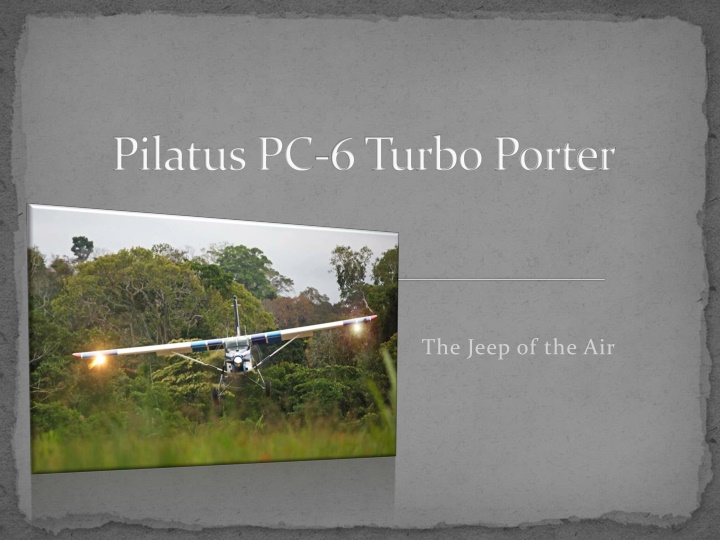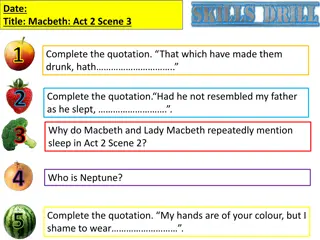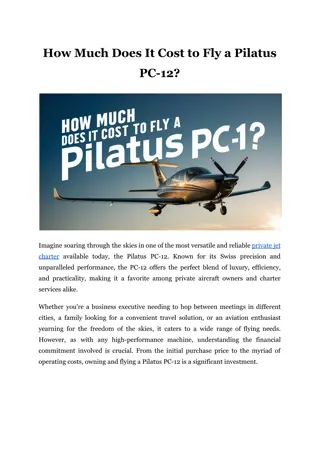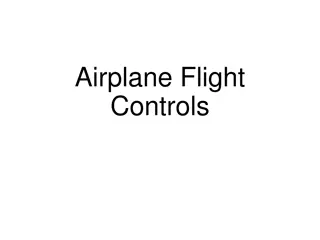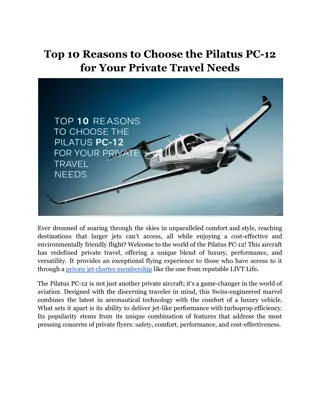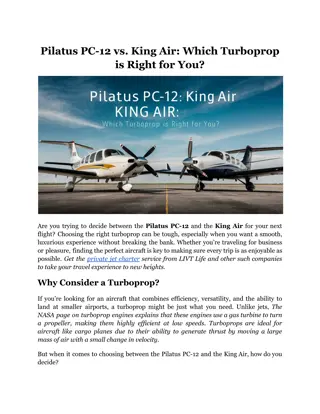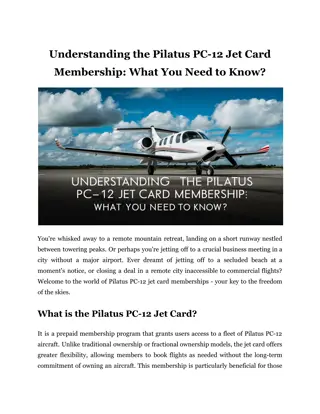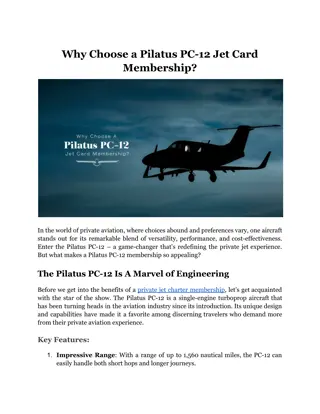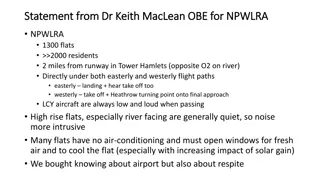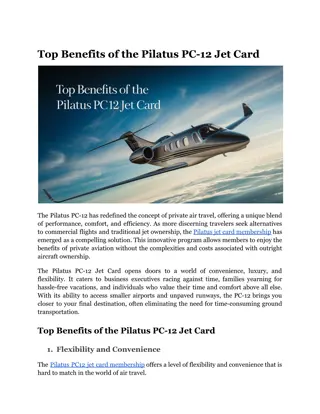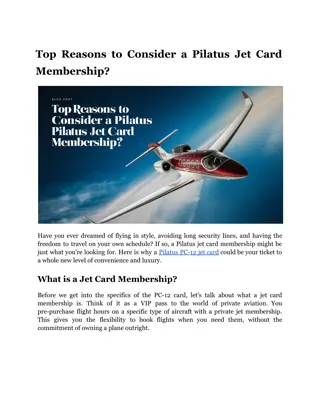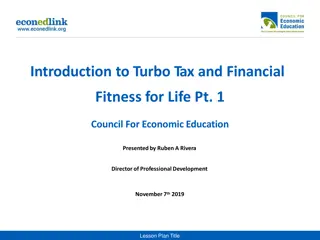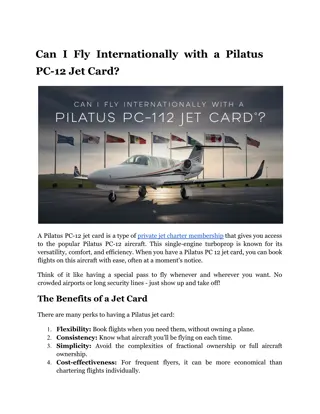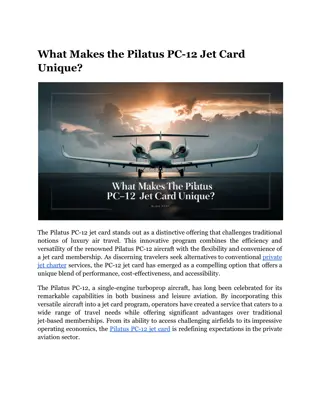Exploring the Versatile Pilatus PC-6 Turbo Porter Airplane
Discover the capabilities of the Pilatus PC-6 Turbo Porter, known as the "Jeep of the Air", for its utility in hauling people and cargo to remote locations inaccessible by helicopters. This versatile aircraft can operate in extreme conditions, with impressive weight and fuel capacities, speed, range, and endurance. Learn about its design basics, engine performance, propeller capabilities, and more.
Uploaded on Sep 22, 2024 | 2 Views
Download Presentation

Please find below an Image/Link to download the presentation.
The content on the website is provided AS IS for your information and personal use only. It may not be sold, licensed, or shared on other websites without obtaining consent from the author.If you encounter any issues during the download, it is possible that the publisher has removed the file from their server.
You are allowed to download the files provided on this website for personal or commercial use, subject to the condition that they are used lawfully. All files are the property of their respective owners.
The content on the website is provided AS IS for your information and personal use only. It may not be sold, licensed, or shared on other websites without obtaining consent from the author.
E N D
Presentation Transcript
Pilatus PC-6 Turbo Porter The Jeep of the Air
Utility Airplane What is it good for? Hauling people and cargo into and out of somewhere that is otherwise accessible only by helicopters Has many configuration options and quick conversions Yeah it has trap doors so be nice to the pilot! https://www.youtube.com/watch?feature=player_embedded&v=euOlF YZIITw Example of STOL
Where can it operate? Cold: to -67 degrees F Hot: to 131 degrees F Desert (Sand), Rocky terrain High density altitudes Snow / Water https://www.youtube.com/watch?v=92ErTsiMwLw Max operating altitude is 25,000 feet It can even handle an occasional paved runway
Weight & Fuel 3,080 pound empty weight 6,173 pound take-off weight Wing tanks = 170 gallons Optional under wing tanks = 128 gallons 39 gallons per hour
Speed, Range, Endurance Never Exceed Speed Vne 151 Design Diving Speed Vd 167 Design Cruise Vc 119 Max Flap Extend Vfe 95 Stall @ Idle with Flaps Up Vs 58 Stall @ Idle with Flaps Down Vso 52 Max Speed Level Flight with Continuous Power Vh 125 Max Endurance is 7 hours 30 minutes Max Range is 870 NM Remember that 10:1 glide ratio?
Distances and Rates Normal Take-off ground roll 646 Normal Distance to 50 1,558 STOL take off distance 1,443 STOL Landing ground roll 417 STOL Landing distance (50 ) 1,033 https://www.youtube.com/watch?v=npEY7zTZ3C8 Climb rate at sea level / 5,000 1,010 / 935 fpm
Lets Talk About That Engine Unlike a piston turbo, it is normally aspirated It taps into its extra power as it encounters less dense air What does 680 SHP flat-rated to 550 SHP mean? 130 SHP in the bank! This is the source of its superior high altitude capability and stable climb rate
Propeller Capabilities A GA airplane with REVERSE What is Beta Mode? Skydive 1 Reverse
Control and Maneuverability Peter Collins review of the modern Porter: I found the PC-6 easy, pleasant and accurate to fly. The control forces were light and well harmonised. The aircraft felt nimble in roll with a sustained roll rate of around 60 /s. Strong adverse yaw was exhibited with any large lateral stick input, but this was quickly corrected by the fin.
Maintainability and Reliability Yes to both They are built by hand and the builders actually sign their names to the airframe in the tail section. Engine has few moving parts & is easily accessed.
Cost Operating :$320/Hr Buy one new for just $1,800,000 Includes: $179.0o Fuel, engine reserve, prop reserve, oil consumption, maintenance labor hours Partial Engine Overhaul $20,000 Total Engine Overhaul: $40,000 Prop Overhaul: $11,500 100 hour inspection: $3200
Disadvantages Yeah, it s slow for an airplane High wing is less maneuverable than a low wing T-tail / V-tail have better spin recovery The trim for the pitch axis has a large amount of authority, so any malfunction causes major control issues Visually unattractive
I still dont see the downside Versatile, rugged, reliable, and capable Landing on foot path
